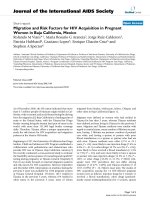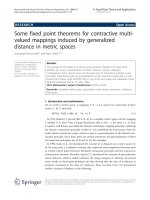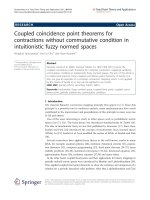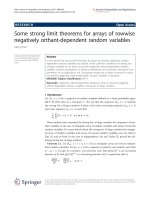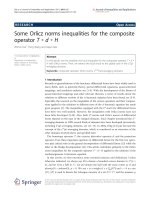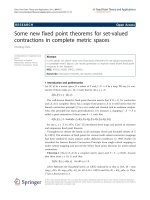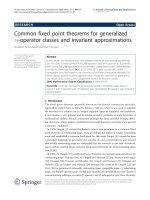Báo cáo hóa học: " Some strong limit theorems for arrays of rowwise negatively orthant-dependent random variables Aiting Shen" pptx
Bạn đang xem bản rút gọn của tài liệu. Xem và tải ngay bản đầy đủ của tài liệu tại đây (255.71 KB, 10 trang )
RESEARC H Open Access
Some strong limit theorems for arrays of rowwise
negatively orthant-dependent random variables
Aiting Shen
Correspondence:
School of Mathematical Science,
Anhui University, Hefei 230039,
China
Abstract
In this article, the strong limit theorems for arrays of rowwise negatively orthant-
dependent random variables are studied. Some sufficient conditions for stro ng law
of large numbers for an array of rowwise negatively orthant-dependent random
variables without assumptions of identical distribution and stochastic domination are
presented. As an application, the Chung-type strong law of large numbers for arrays
of rowwise negatively ort hant-dependent random variables is obtained.
MR(2000) Subject Classification: 60F15
Keywords: negatively orthant-dependent sequence, array of rowwise negatively
orthant-dependent random variables, strong law of large numbers
1 Introduction
Let {X
n
, n ≥ 1} be a sequence of random variabl es defined on a fixed probab ility space
(
, F , P
)
with value in a real spa ce ℝ. We say that the sequence {X
n
, n ≥ 1} satisfies
the strong law of large numbers if there exist some increasing sequence {a
n
, n ≥ 1}
and some sequence {c
n
, n ≥ 1} such that
1
a
n
n
i
=1
(X
i
− c
i
) → 0a.s.asn →∞
.
Many authors have extended the strong law of large numbers for sequences of ran-
dom variables to the case of triangular array of random variables and arrays of rowwise
random variables. For more details about the strong law of large numbers for triangu-
lar array of random variables and arrays of rowwise random variables, one can refer to
Gut [1], and so forth. In the case of independence, Hu and Taylor [2] proved the fol-
lowing strong law of large numbers.
Theorem 1.1. Let {X
ni
:1≤ i ≤ n, n ≥ 1} be a triangular array of rowwise indepen-
dent random variables. Let {a
n
, n ≥ 1} be a sequence of positive real numbers such that
0 <a
n
↑ ∞.Letg(t) be a positive, even function such that g(|t|)/|t|
p
is an increasing
function of |t| and g(|t|)/|t|
p+1
is a decreasing function of |t|, respectively, that is,
g
(|t|)
|
t
|
p
↑,
g(|t|)
|
t
|
p+1
↓ as |t|↑
Shen Journal of Inequalities and Applications 2011, 2011:93
/>© 2011 Shen; licensee Springer. This is an Open Access article distributed under the terms of the Creative Commons Attribution
License ( /by/2.0), which permits unrestricted use, distribution, and reproduction in any medium,
provided the original work is prope rly cited .
for some nonnegative integer p. If p ≥ 2 and
EX
ni
=0,
∞
n=1
n
i=1
E
g(|X
ni
|)
g(a
n
)
< ∞,
∞
n=1
n
i=1
E
X
ni
a
n
2
2k
< ∞
,
where k is a positive integer, then
1
a
n
n
i
=1
X
ni
→ 0 a.s
.
In this article, we will consider the strong law of large numbers for arrays of rowwise
negatively associated (NA) random variables. A finite collection of random variables
X
1
, X
2
, ,X
n
is said to be negatively orthant dependent (NOD) if
P( X
1
> x
1
, X
2
> x
2
, , X
n
> x
n
) ≤
n
i
=1
P( X
i
> x
i
)
and
P( X
1
≤ x
1
, X
2
≤ x
2
, , X
n
≤ x
n
) ≤
n
i
=1
P( X
i
≤ x
i
)
for all x
1
, x
2
, ,x
n
Î ℝ. An infinite sequence {X
n
, n ≥ 1} is said to be NOD if every
finite subcollection is NOD.
An array of random variables {X
ni
, i ≥ 1, n ≥ 1} is called rowwise NOD random vari-
ables if for every n ≥ 1, {X
ni
, i ≥ 1} is a sequence of NOD random variables.
The concept of NOD sequence was introduced by Joag-Dev and Proschan [3].
Obviously, independent random variables are NOD. Joag-Dev and Proschan [3] pointed
out that NA (one can refer to Joag-Dev and Proschan [3]) random variables are NOD.
They also presented an example in which X =(X
1
, X
2
, X
3
, X
4
) possesses NOD, but
does not possess NA. So we can see that NOD is weaker than NA. A number of limit
theorems for NOD random variables have been established by many authors. We refer
to Volodin [4] for the Kolmogorov exponential inequality, Asadian et al. [5] for the
Rosental’ s-type inequality, Amini et al. [6,7], Klesov et al. [8], and Li et al. [9] for
almost sure convergence, Amini and Bozorgnia [10,11], Kuczmaszewska [12], Taylor et
al. [13], Zarei and Jabbari [14] and Wu [15] for complete convergence, and so on.
The main purpose of this article is to study the strong limit theorems for arrays of
rowwise NOD random variables. As an application, the Chung-type strong law of large
numbers for arrays of rowwise NOD random variables is obtain ed. We will give some
sufficient conditions for strong law of large numbers for an array of rowwise NOD
random variables without assumptions of identical distribution and stochastic domina-
tion. The results presented in this article are obtained using the truncated method and
the Rosental’s-type inequality of NOD random variables.
The main results of this article are depending on the following lemmas:
Lemma 1.1 (cf. Bozorgnia et al. [16]). Let random variables X
1
, X
2
, ,X
n
be NOD,
f
1
, f
2
, ,f
n
be all nondecreasing (or all nonincreasing) functions, then random vari-
ables f
1
(X
1
), f
2
(X
2
), ,f
n
(X
n
) are NOD.
Shen Journal of Inequalities and Applications 2011, 2011:93
/>Page 2 of 10
Lemma 1.2 (cf. Asadian et al. [5]). Let p ≥ 2 and {X
n
, n ≥ 1} be a sequence of NOD
random variables with EX
n
=0and E|X
n
|
p
<∞ for every n ≥ 1. Then, there exists a
positive constant C = C(p) depending only on p such that for every n ≥ 1
E
n
i=1
X
i
p
≤ C
n
i=1
E|X
i
|
p
+
n
i=1
EX
2
i
p/2
.
Throughout the article, let I(A) be the indicator function of the set A. C denotes a
positive constant which may be different in various places.
2 Main results
In this section, we will give some sufficient conditions for strong law of large numbers
for an array of rowwise NOD random variables without assumptions of identical distri-
bution and stochastic domination. Our main results are as follows.
Theorem 2.1. Let {X
ni
: i ≥ 1, n ≥ 1} be an array of rowwis e NOD random variable s
and {a
n
, n ≥ 1} be a sequence of positive real numbers. Let {g
n
(t), n ≥ 1} be a sequence
of positive, even functions such that g
n
(|t|) is an increasing function of |t| and g
n
(|t|)/|t|
is a decreasing function of |t| for every n ≥ 1, respectively, that is
g
n
(|t|) ↑,
g
n
(|t|)
|
t
|
↓ as |t|↑.
If
∞
n=1
n
i=1
Eg
n
(|X
ni
|)
g
n
(
a
n
)
< ∞
,
(2:1)
then for any ε >0,
∞
n=1
P
1
a
n
n
i=1
X
ni
>ε
< ∞
.
(2:2)
Proof. For fixed n ≥ 1, define
X
(
n
)
i
= −a
n
I(X
ni
< −a
n
)+X
ni
I(|X
ni
|≤a
n
)+a
n
I(X
ni
> a
n
), i ≥ 1
,
T
(n)
j
=
1
a
n
j
i
=1
X
(n)
i
− EX
(n)
i
, j =1,2, , n.
By Lemma 1.1, we can see that for fixed n ≥ 1,
{
X
(n)
i
, i ≥ 1
}
is still a sequence of NOD
random variables. It is easy to check that for any ε >0,
1
a
n
n
i=1
X
ni
>ε
⊂
max
1≤i≤n
|X
ni
| > a
n
∪
1
a
n
n
i=1
X
(n)
i
>ε
,
which implies that
P
1
a
n
n
i=1
X
ni
>ε
≤ P
max
1≤i≤n
|X
ni
| > a
n
+ P
1
a
n
n
i=1
X
(n)
i
>ε
≤
n
i=1
P
(
|X
ni
| > a
n
)
+ P
T
(n)
n
>ε−
1
a
n
n
i=1
EX
(n)
i
.
(2:3)
Shen Journal of Inequalities and Applications 2011, 2011:93
/>Page 3 of 10
First, we will show that
1
a
n
n
i=1
EX
(n)
i
→ 0asn →∞
.
(2:4)
Actually, by conditions g
n
(|t|) ↑, g
n
(|t|)/|t| ↓ as |t| ↑ and (2.1), we have that
1
a
n
n
i=1
EX
(n)
i
≤
n
i=1
P
(
|X
ni
| > a
n
)
+
1
a
n
n
i=1
E|X
ni
|I(|X
ni
|≤a
n
)
≤
n
i=1
Eg
n
(|X
ni
|)
g
n
(a
n
)
+
n
i=1
Eg
n
(|X
ni
|)I(|X
ni
|≤a
n
)
g
n
(a
n
)
≤ 2
n
i
=1
Eg
n
(|X
ni
|)
g
n
(a
n
)
→ 0asn →∞,
which implies (2.4). It follows from (2.3) and (2.4) that for n large enough,
P
1
a
n
n
i=1
X
ni
>ε
≤
n
i=1
P
(
|X
ni
| > a
n
)
+ P
T
(n)
n
>
ε
2
.
Hence, to prove (2.2), we only need to show that
∞
n=1
n
i
=1
P
(
|X
ni
| > a
n
)
< ∞
(2:5)
and
∞
n
=1
P
T
(n)
n
>
ε
2
< ∞
.
(2:6)
The conditions g
n
(|t|) ↑ as |t| ↑ and (2.1) yield that
∞
n=1
n
i
=1
P
(
|X
ni
| > a
n
)
≤
∞
n=1
n
i
=1
Eg
n
(|X
ni
|)
g
n
(a
n
)
< ∞,
which implies (2.5).
By Markov’s inequality, Lemma 1.2 (for p =2),g
n
(|t|) ↑, g
n
(|t|)/|t| ↓ as |t | ↑ and
(2.1), we can get that
∞
n=1
P
T
(n)
n
>
ε
2
≤ C
∞
n=1
E
T
(n)
n
2
≤ C
∞
n=1
1
a
2
n
n
i=1
E
X
(n)
i
2
≤ C
∞
n=1
n
i=1
P
(
|X
ni
| > a
n
)
+ C
∞
n=1
n
i=1
E|X
ni
|
2
I(|X
ni
|≤a
n
)
a
2
n
≤ C
∞
n=1
n
i=1
|Eg
n
(|X
ni
|)
g
n
(a
n
)
+ C
∞
n=1
n
i=1
E|X
ni
|
2
I(|X
ni
|≤a
n
)
a
2
n
≤ C
∞
n=1
n
i=1
Eg
n
(|X
ni
|)
g
n
(a
n
)
+ C
∞
n=1
n
i=1
Eg
n
(|X
ni
|)I(|X
ni
|≤a
n
)
g
n
(a
n
)
≤ C
∞
n=1
n
i
=1
Eg
n
(|X
ni
|)
g
n
(a
n
)
< ∞,
Shen Journal of Inequalities and Applications 2011, 2011:93
/>Page 4 of 10
which implies (2.6). This completes the proof of the theorem. □
Corollary 2.1. Under the conditions of Theorem 2.1,
1
a
n
n
i
=1
X
ni
→ 0 a.s
.
Theorem 2.2. Let {X
ni
: i ≥ 1, n ≥ 1} be an array of rowwis e NOD random variable s
and {a
n
, n ≥ 1} be a sequence of positive real numbers. Let {g
n
(t), n ≥ 1} be a sequence
of nonnegative, even functions such that g
n
(|t|) is an increasing function of |t| for every
n ≥ 1. Assume that there exists a constant δ >0 such that g
n
(t) ≥ δt for 0 <t≤ 1. If
∞
n=1
n
i
=1
Eg
n
X
ni
a
n
< ∞
,
(2:7)
then for any ε >0, (2.2) holds true.
Proof. We use the same notations as that in Theorem 2.1. The proof is similar to
that of Theorem 2.1.
First, we will show that (2.4) holds true. In fact, by the conditions g
n
(t) ≥ δt for 0 <t
≤ 1 and (2.7), we have that
1
a
n
n
i=1
EX
(n)
i
≤
n
i=1
P
(
|X
ni
| > a
n
)
+
n
i=1
E
|X
ni
|
a
n
I(|X
ni
|≤a
n
)
≤
1
δ
n
i=1
Eg
n
X
ni
a
n
+
1
δ
n
i=1
Eg
n
X
ni
a
n
I(|X
ni
|≤a
n
)
≤
2
δ
n
i
=1
Eg
n
X
ni
a
n
→ 0asn →∞,
which implies (2.4).
According to the proof of Theorem 2.1, we only need to prove that (2.5) and (2.6)
hold true.
When |X
ni
| >a
n
>0, we have
g
n
X
ni
a
n
≥ g
n
(1) ≥
δ
, which yields that
P( |X
ni
| > a
n
)=EI(|X
ni
| > a
n
) ≤
1
δ
Eg
n
X
ni
a
n
.
Hence,
∞
n=1
n
i
=1
P
(
|X
ni
| > a
n
)
≤
1
δ
∞
n=1
n
i
=1
Eg
n
X
ni
a
n
< ∞
,
which implies (2.5).
By Markov ’ s inequality, Lemma 1.2 (for p =2),g
n
(t) ≥ δt for 0 <t≤ 1 and (2.7), we
can get that
Shen Journal of Inequalities and Applications 2011, 2011:93
/>Page 5 of 10
∞
n=1
P
T
(n)
n
>
ε
2
≤ C
∞
n=1
n
i=1
P
(
|X
ni
| > a
n
)
+ C
∞
n=1
n
i=1
E|X
ni
|
2
I(|X
ni
|≤a
n
)
a
2
n
≤ C + C
∞
n=1
n
i=1
E|X
ni
|I(|X
ni
|≤a
n
)
a
n
≤ C + C
∞
n=1
n
i=1
Eg
n
X
ni
a
n
I(|X
ni
|≤a
n
)
≤ C + C
∞
n=1
n
i=1
Eg
n
X
ni
a
n
< ∞,
which implies (2.6). This completes the proof of the theorem. □
Corollary 2.2. Let {X
ni
, i ≥ 1, n ≥ 1} be an array of rowwise NOD random variables
and {a
n
, n ≥ 1} be a sequence of positive real numbers. If there exists a constant b Î (0,
1] such that
∞
n=1
n
i
=1
E
|X
ni
|
β
|a
n
|
β
+ |X
ni
|
β
< ∞
,
then (2.2) holds true.
Proof. In Theorem 2.2, we take
g
n
(t ) ≡
|t|
β
1+
|
t
|
β
,0<β≤ 1, n ≥ 1
.
It is easy to check that {g
n
(t), n ≥ 1}isasequenceofnonnegative,evenfunctions
such that g
n
(|t|) is an increasing function of |t| for every n ≥ 1. And
g
n
(t ) ≥
1
2
t
β
≥
1
2
t,0< t ≤ 1, 0 <β≤ 1
.
Therefore, by Theorem 2.2, we can easily get (2.2). □
Corollary 2.3. Under the conditions of Theorem 2.2 or Corollary 2.2,
1
a
n
n
i
=1
X
ni
→ 0 a.s
.
Theorem 2.3. Let {X
ni
: i ≥ 1, n ≥ 1} be an array of rowwise NOD random variables
and {a
n
, n ≥ 1} be a sequence of positive real numbers. EX
ni
=0,i ≥ 1, n ≥ 1. Let {g
n
(x), n ≥ 1} be a sequence of nonnegative, even functions. Assume that there exist b Î (1,
2] and δ >0 such that g
n
(x) ≥ δx
b
for 0<x ≤ 1 and there exists a δ >0 such that g
n
(x) ≥
δx for x >1.If (2.7) satisfies, then for any ε >0, (2.2) holds true.
Proof. We use the same notations as that in Theorem 2.1. The proof is similar to
that of Theorem 2.1.
First, we will show that (2.4) holds true. Actually, by the conditions EX
ni
=0,g
n
(x) ≥
δx for x>1 and (2.7), we have that
Shen Journal of Inequalities and Applications 2011, 2011:93
/>Page 6 of 10
1
a
n
n
i=1
EX
(n)
i
≤
n
i=1
P
(
|X
ni
| > a
n
)
+
1
a
n
n
i=1
EX
ni
I(|X
ni
| > a
n
)
≤ 2
n
i=1
E
|X
ni
|
a
n
I(|X
ni
| > a
n
)
≤
2
δ
n
i=1
Eg
n
X
ni
a
n
I(|X
ni
| > a
n
)
≤
2
δ
n
i
=1
Eg
n
X
ni
a
n
→ 0asn →∞,
which implies (2.4). Hence, to prove (2.2), we only need to show that (2.5) and (2.6)
hold true.
The conditions g
n
(x) ≥ δx for x>1 and (2.1) yield that
∞
n=1
n
i=1
P
(
|X
ni
| > a
n
)
=
∞
n=1
n
i=1
EI
(
|X
ni
| > a
n
)
≤
∞
n=1
n
i=1
E
|X
ni
|
a
n
I
(
|X
ni
| > a
n
)
≤
1
δ
∞
n=1
n
i=1
Eg
n
X
ni
a
n
I
(
|X
ni
| > a
n
)
≤
1
δ
∞
n=1
n
i
=1
Eg
n
X
ni
a
n
< ∞,
which implies (2.5).
By Markov’s inequality, Lemma 1.2 (for p =2),g
n
(x) ≥ δx
b
for 1 < b ≤ 2, 0 <x ≤ 1
and (2.7), we can get that
∞
n=1
P
T
(n)
n
>
ε
2
≤ C
∞
n=1
n
i=1
P
(
|X
ni
| > a
n
)
+ C
∞
n=1
n
i=1
E|X
ni
|
2
I(|X
ni
|≤a
n
)
a
2
n
≤ C + C
∞
n=1
n
i=1
E|X
ni
|
β
I(|X
ni
|≤a
n
)
a
β
n
≤ C + C
∞
n=1
n
i=1
Eg
n
X
ni
a
n
I(|X
ni
|≤a
n
)
≤ C + C
∞
n=1
n
i=1
Eg
n
X
ni
a
n
< ∞,
which implies (2.6). This completes the proof of the theorem. □
Corollary 2.4. Let {X
ni
, i ≥ 1, n ≥ 1} be an array of rowwise NOD random variables
and {a
n
, n ≥ 1} be a sequence of positive real numbers. EX
ni
=0,i ≥ 1, n ≥ 1. If there
exists a constant b Î (1, 2] such that
∞
n=1
n
i=1
E
|X
ni
|
β
a
n
|X
ni
|
β−1
+ a
β
n
< ∞
,
then (2.2) holds true.
Shen Journal of Inequalities and Applications 2011, 2011:93
/>Page 7 of 10
Proof. In Theorem 2.3, we take
g
n
(x) ≡
|x|
β
1+
|
x
|
β−1
,1<β≤ 2, n ≥ 1
.
It is easy to check that {g
n
(x), n ≥ 1} is a sequence of nonnegative, even functions
satisfying
g
n
(x) ≥
1
2
x
β
,0< x ≤ 1, 1 <β≤ 2andg
n
(x) ≥
1
2
x, x > 1
.
Therefore, by Theorem 2.3, we can easily get (2.2). □
Furthermore, by Corollaries 2.2 and 2.4, we can get the following importa nt Chung-
type strong law of large numbers for arrays of rowwise NOD random variables.
Corollary 2.5. Let {X
ni
, i ≥ 1, n ≥ 1} be an array of rowwise NOD random variables
and {a
n
, n ≥ 1} be a sequence of positive real numbers. If there exists some b Î (0, 2]
such that
∞
n=1
n
i
=1
E|X
ni
|
β
a
β
n
< ∞
,
(2:8)
and EX
ni
=0,i ≥ 1, n ≥ 1 if b Î (1, 2], then (2.2) holds true and
1
a
n
n
i=1
X
ni
→ 0 a.s
.
.
For b ≥ 2, we have the following result.
Theorem 2.4. Let {X
ni
: i ≥ 1, n ≥ 1} be an array of rowwise NOD random variables
and {a
n
, n ≥ 1} be a sequence of positive real numbers. Let {g
n
(x), n ≥ 1} be a sequence
of nonnegative, even functions. Assume that there exists some b ≥ 2 such that g
n
(x) ≥
δx
b
for x >0.If
∞
n=1
n
i
=1
Eg
n
X
ni
a
n
1/β
< ∞
,
(2:8a)
then for any ε >0, (2.2) holds true.
Proof. We use the same notations as that in Theorem 2.1. The proof is similar to
that of Theorem 2.1. It is easily seen that (2.8) implies that
∞
n=1
n
i
=1
Eg
n
X
ni
Ma
n
<
∞
(2:9)
and
∞
n=1
n
i
=1
Eg
n
X
ni
Ma
n
2/β
< ∞
.
(2:10)
First, we will show that (2.4) holds true. In fact, by Hölder’s inequality, g
n
(x) ≥ δx
b
for x>0, (2.8) and (2.9), we have that
Shen Journal of Inequalities and Applications 2011, 2011:93
/>Page 8 of 10
1
a
n
n
i=1
EX
(n)
i
≤
n
i=1
P
(
|X
ni
| > a
n
)
+
n
i=1
E
|X
ni
|
a
n
I(|X
ni
|≤a
n
)
≤
n
i=1
E
|X
ni
|
β
a
β
n
I(|X
ni
| > a
n
)
+
n
i=1
E
|X
ni
|
β
a
β
n
I(|X
ni
|≤a
n
)
1/
β
≤ C
n
i=1
Eg
n
X
ni
a
n
+ C
n
i=1
Eg
n
X
ni
a
n
I(|X
ni
|≤a
n
)
1/β
≤ C
n
i
=1
Eg
n
X
ni
a
n
+ C
n
i
=1
Eg
n
X
ni
a
n
1/β
→ 0asn →∞,
which implies (2.4). To prove (2.2), we only need to show that (2.5) and (2.6) hold
true.
By the condition g
n
(x) ≥ δx
b
for x>0 again and (2.9), we have
∞
n=1
n
i=1
P
(
|X
ni
| > a
n
)
=
∞
n=1
n
i=1
EI(|X
ni
| > a
n
)
≤
∞
n=1
n
i=1
E
|X
ni
|
β
a
β
n
I(|X
ni
| > a
n
)
≤
1
δ
∞
n=1
n
i
=1
Eg
n
X
ni
a
n
< ∞,
which implies (2.5).
By Markov’s inequality, Lemma 1.2 (for p =2),g
n
(x) ≥ δx
b
for x>0 and (2.10), we
can get that
∞
n=1
P
T
(n)
n
>
ε
2
≤ C
∞
n=1
n
i=1
P
(
|X
ni
| > a
n
)
+ C
∞
n=1
n
i=1
E|X
ni
|
2
I(|X
ni
|≤a
n
)
a
2
n
≤ C + C
∞
n=1
n
i=1
E
|X
ni
|
β
a
β
n
I(|X
ni
|≤a
n
)
2/β
≤ C + C
∞
n=1
n
i=1
Eg
n
X
ni
a
n
I(|X
ni
|≤a
n
)
2/β
≤ C + C
∞
n=1
n
i
=1
Eg
n
X
ni
a
n
2/β
< ∞,
which implies (2.6). This completes the proof of the theorem. □
Acknowledgements
The author was most grateful to the Editor Andrei Volodin and anonymous referees for careful reading of the
manuscript and valuable suggestions which helped in improving an earlier version of this article.
Supported by the National Natural Science Foundation of China (11171001, 71071002) and the Academic Innovation
Team of Anhui University (KJTD001B).
Competing interests
The authors declare that they have no competing interests.
Received: 18 April 2011 Accepted: 26 October 2011 Published: 26 October 2011
References
1. Gut, A: Complete convergence for arrays. Periodica Math Hungarica. 25(1):51–75 (1992). doi:10.1007/BF02454383
Shen Journal of Inequalities and Applications 2011, 2011:93
/>Page 9 of 10
2. Hu, TC, Taylor, RL: On the strong law for arrays and for the bootstrap mean and variance. Int J Math Math Sci. 20(2),
375–382 (1997). doi:10.1155/S0161171297000483
3. Joag-Dev, K, Proschan, F: Negative association of random variables with applications. Ann Stat. 11(1):286–295 (1983).
doi:10.1214/aos/1176346079
4. Volodin, A: On the Kolmogorov exponential inequality for negatively dependent random variables. Pakistan J Stat. 18,
249–254 (2002)
5. Asadian, N, Fakoor, V, Bozorgnia, A: Rosental’s type inequalities for negatively orthant dependent random variables. J
Iranian Stat Soc. 5(1-2):66–75 (2006)
6. Amini, M, Azarnoosh, HA, Bozorgnia, A: The strong law of large numbers for negatively dependent generalized
Gaussian random variables. Stochast Anal Appl. 22, 893–901 (2004)
7. Amini, M, Zarei, H, Bozorgnia, A: Some strong limit theorems of weighted sums for negatively dependent generalized
Gaussian random variables. Stat Probab Lett. 77, 1106–1110 (2007). doi:10.1016/j.spl.2007.01.015
8. Klesov, O, Rosalsky, A, Volodin, A: On the almost sure growth rate of sums of lower negatively dependent nonnegative
random variables. Stat Probab Lett. 71, 193–202 (2005). doi:10.1016/j.spl.2004.10.027
9. Li, D, Rosalsky, A, Volodin, A: On the strong law of large numbers for sequences of pairwise negative quadrant
dependent random variables. Bull Inst Math Acad Sin (New Ser). 1(2), 281–305 (2006)
10. Amini, M, Bozorgnia, A: Negatively dependent bounded random variable probability inequalities and the strong law of
large numbers. J Appl Math Stochast Anal. 13, 261–267 (2000). doi:10.1155/S104895330000023X
11. Amini, M, Bozorgnia, A: Complete convergence for negatively dependent random variables. J Appl Math Stochast Anal.
16, 121–126 (2003). doi:10.1155/S104895330300008X
12. Kuczmaszewska, A: On some conditions for complete convergence for arrays of rowwise negatively dependent random
variables. Stochast Anal Appl. 24, 1083–1095 (2006). doi:10.1080/07362990600958754
13. Taylor, RL, Patterson, RF, Bozorgnia, A: A strong law of large numbers for arrays of rowwise negatively dependent
random variables. Stochast Anal Appl. 20, 643–656 (2002). doi:10.1081/SAP-120004118
14. Zarei, H, Jabbari, H: Complete convergence of weighted sums under negative dependence. Stat Pap. (2009)
15. Wu, QY: Complete convergence for negatively dependent sequences of random variables. J Inequal Appl 2010,10
(2010). Article ID 507293
16. Bozorgnia, A, Patterson, RF, Taylor, RL: Limit theorems for dependent random variables. World Congress Nonlinear
Analysts’92. 1639–1650 (1996)
doi:10.1186/1029-242X-2011-93
Cite this article as: Shen: Some strong limit theorems for arrays of rowwise negatively orthant-dependent
random variables. Journal of Inequalities and Applications 2011 2011:93.
Submit your manuscript to a
journal and benefi t from:
7 Convenient online submission
7 Rigorous peer review
7 Immediate publication on acceptance
7 Open access: articles freely available online
7 High visibility within the fi eld
7 Retaining the copyright to your article
Submit your next manuscript at 7 springeropen.com
Shen Journal of Inequalities and Applications 2011, 2011:93
/>Page 10 of 10


